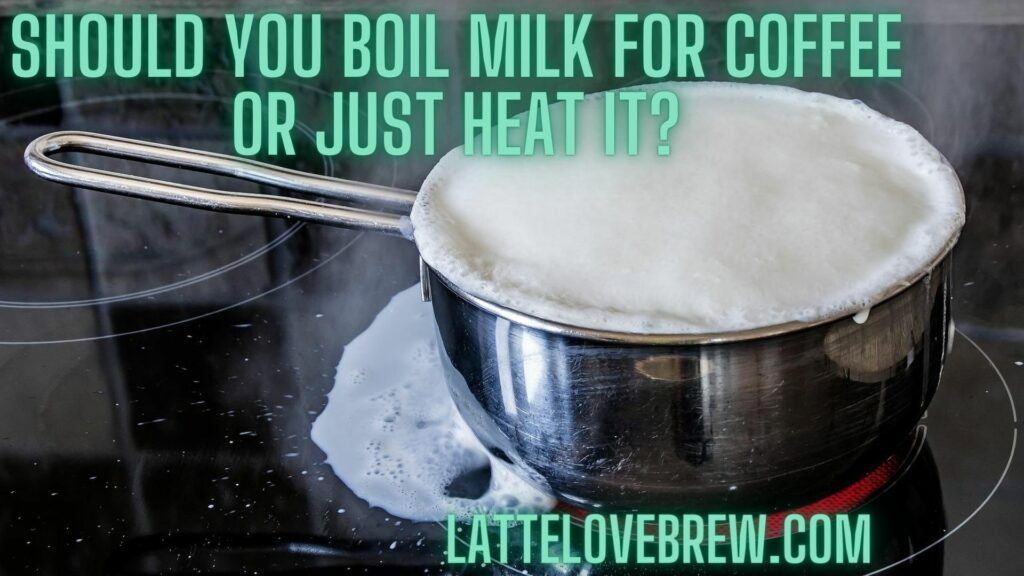Last updated on July 28th, 2024 at 14:21
When you have a sour espresso shot something has gone wrong, and you need to figure out why you have pulled a pulled sour shot of espresso and how to fix it.
This article will address all the main causes and let you know why your espresso tastes sour and the simple and effective adjustments that you can make to fix the problem.
If you are in a rush – please don’t skip over this article as it will help you. Here is a quick diagnosis.
A sour coffee, even a shot of espresso and even drip coffee (or any coffee drink) is the result of an under-extracted coffee in the most common case. In the case of an espresso shot, the hot water has passed through your coffee grounds too quickly, resulting in a short extraction time.
Three quick solutions are focusing on your tamping and tamp firmer, use more grounds, thirdly, try a finer grind.
Make just one adjustment at a time.
Keep reading as we dig down and detail the topic of fixing and dealing with a sour espresso shot!
What Is A Sour Espresso Shot?
Table Of Contents
- 1 What Is A Sour Espresso Shot?
- 2 Pulled A Sour Espresso Shot – Start Trouble Shooting
- 2.1 Your Coffee Beans Must Be Perfect For An Espresso
- 2.2 You Must Use The Best Type Of Grinder
- 2.3 Use The Correct Grind Size
- 2.4 Your Coffee Brewing Gear Must Be Clean
- 2.5 Cleaning Your Espresso Machine And Your Grinder
- 2.6 Dose And The Coffee To Water Ratio
- 2.7 Sour Espresso Temperature – Brew At The Correct Temperature
- 2.8 Yield And Extraction Time
- 2.9 Check And Focus On Your Tamp
- 2.10 Check Your Water And Water Filters
- 3 Frequently Asked Questions About Sour Espresso Shot
- 3.1 Is Espresso Supposed To Be A Little Sour?
- 3.2 How Do You Get Rid Of Sour In Espresso?
- 3.3 Is Espresso Supposed To Be Acidic?
- 3.4 What Causes Sour Taste In Espresso?
- 3.5 Are Espresso Shots Supposed To Be Sour?
- 3.6 Why Does My Espresso Taste Bitter Or Sour?
- 3.7 Is Sour Espresso Overextracted?
- 3.8 Can You Tamp Espresso Too Hard?
- 4 Frappé-Ing It All Up – Sour Espresso Shot
Unfortunately, a sour taste in an espresso shot is common and something that will happen from time to time. There is no getting past the unpleasant and bad taste. You absolutely must focus on what is causing it.
As you gain experience with your home espresso machine, you will get to know the tell-tale signs and know exactly what the problem is and what you need to do to fix it in a second.
Let’s dig down and talk about the main causes, from Crema to the puck and to the taste.
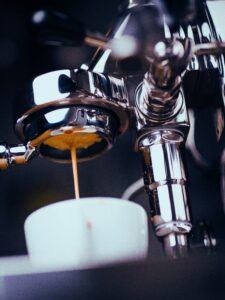
Read: How to grind espresso beans
Flavor
The most important indicator and where the tell-tale sign is – the obvious sour taste that is noticeable and overwhelms all other flavors. You simply can’t hide from the good old-fashioned taste test.
Crema
A perfect and world-class espresso has a thick rich crema on top. The cream is the result of fresh coffee oil on the exterior of dark roasted coffee beans. The ideal crema color should be a rich-looking brown color. The darker the color crema the better its quality.
If you see a pale yellow or blonding of your crema or one that is thin and light, you should know by what you see that something is wrong.
Puck
You can easily tell if you have pulled a sour espresso the moment you see your coffee puck. The coffee grounds in your portafilter will be more saturated than you would expect it to be. They will be very mud-like and not at all like what you would expect.
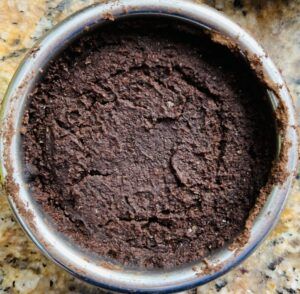
Read: How to make coffee less acidic
Pulled A Sour Espresso Shot – Start Trouble Shooting
Okay,
you pulled a sour shot, and you noticed it due to what you have learned above. Now let’s get talking about what you can do to remedy the situation and ensure that you do not pull any more sour shots.
Your Coffee Beans Must Be Perfect For An Espresso
The most obvious starting point is your coffee beans. Using the simple Ferrari principle of the best components and the best equipment, you will get the best coffee, the best results. I find single origin and single-sourced beans are best.
Use high-quality coffee beans and ensure that they are fresh and of a dark roast. Ensure your beans are fresh by checking the roast date and use them no later than 7 to 10 days after they have been roasted.
The peak flavor for coffee beans is that window that is 2 to 3 days after roasting and 7 to 10 days after.
Old coffee beans that are two weeks or more beyond the roasted on date can make your coffee sour and no amount of adjusting with your espresso machine will fix that.
You Must Use The Best Type Of Grinder
The importance that a humble coffee grinder plays in the process of coffee brewing is something I talk about in many posts on this blog.
Stop using a blade grinder, if this is the type of coffee grinder that you have. A blade grinder that you have will produce an inconsistent grind. An inconsistent uneven grind size will result in an uneven extraction.
You will also have the issue of excessive heat dissipation “cooking” your coffee grinds and blooming them early.
Also, due to the heat issue with a blade grinder, you need to grind in bursts, which leads to oxidization and deterioration of your beans and a slight reduction in the flavor quality prior to brewing.
A ceramic conical burr grinder will solve all the issues of a flat blade grinder and get you a finer grind and better quality, more consistent grind.
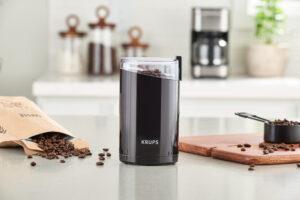
Use The Correct Grind Size
A sour or bitter espresso shot can be the result of an incorrect grind size. If it gets over extracted, adjust the grind size slightly and look for a slightly larger coarser grind size to allow the hot water to pass through your grinds faster.
If you are getting a muddy coffee puck and a sour shot, you may need to use a slightly smaller grind size. This will ensure that your water passes through slower and the water has increased contact with the ground coffee.
Your Coffee Brewing Gear Must Be Clean
The cleaner your coffee brewing equipment is, the better the quality your coffee will be. There is no exception to this rule.
Ensure that all parts of all your coffee gear are clean…always. Coffee is a food product. Never forget that. You would not cook with a dirty pot or cut your meat and vegetables with a dirty knife. Have the same attitude towards coffee and keep your grinder and your espresso machine clean.
Coffee oils and coffee grounds get stuck everywhere. Absolutely everywhere. The result can be an off-taste rancid coffee.
Cleaning Your Espresso Machine And Your Grinder
Cleaning your grinder is easy. I strongly advise that you keep it clean by giving it a good blow out with a canister of pressurized air and dust down after every single use. Wipe the ceramic conical burrs with a hot damp sponge to remove any oils.
A dirty coffee machine can make your espresso taste sour, you can also experience, unwanted bitter taste and bitter flavors.
Old coffee oils and grounds will get stuck inside your portafilter and grouphead. Clean them after every use.
As a coffee lover and experienced coffee shop barista I advise that you clean your machine after every single shot.
At my coffee shop, while it is impossible to clean after every single shot, the machine is cleaned every single day – several times. It is cleaned after the morning rush hour, after the afternoon, lunchtime rush and in the evening and before closing.
As a result, we are known for our excellent and world-class coffee.
Cleaning is not a big chore. It’s easy. Simply rinse the portafilter, removing all parts, (if any depending on the design) in hot, almost boiling water.
Take a soapy sponge and give the parts a good wipe down and rinse well in an abundance of water. Then let the grouphead run about to rinse it of any oils or grounds and give it a good wipe with a soapy sponge. Then allow an abundance of water to run from the group head.
At this point, I like to be double sure that no soap particles are in either the grouphead or portafilter by attaching the empty portafilter and filling a jug with hot water, running a rinse cycle.
If you are finished with making coffee for the day, you have more cleaning options. It is likely that your espresso machine has a three-way overpressure valve.
It is important to take advantage of this and perform a quick backflush. The quick backflush will clean your whole system, including the pipes. This is a must-do daily task to keep it clean and clear of any mineral deposits and lime scale.
Always ensure that you have read the cleaning instructions for your particular espresso machine and keep it clean.

Dose And The Coffee To Water Ratio
Altering your coffee to water ratio and making sure you have the correct amount of coffee in your portafilter can help to fix that off-taste sour shot.
The ratio and, effectively speaking, the dosage of coffee is the ratio of coffee to water.
The standard ratio of coffee to water for an espresso is 1:1.5 or 1:2 depending on the establishment. 1 part coffee to 1.5 or 2 parts water.
Typically, 18 to 21 grams of coffee is used to brew a shot of espresso.
If you are brewing with a coffee of a lighter roast to get a great espresso roast you can try with a smaller dose of 17-19 grams of coffee. This should help you offset the reduction in solubility when compared to a darker roast.
If you are pulling your shot for a milk based espresso drink, a higher ratio and stronger shot will be required to cut through the milk and make the coffee flavor stand out.
You should also take into consideration the type of coffee that you are using, since different coffees like a light roast may need a higher ratio of 1:2.5 or 1:3 to get it right and not just to fix that sour tasting espresso.
When you make your adjustments, do so only in a quarter of a gram 0.25 increments on your coffee scale.
You also want to consider the type of coffee you’re using, since a light roast or certain varieties might require a ratio as high as 1:3. If you need to adjust the dose, do so in small increments (0.2 grams) at a time. If your grinder does not have an on-demand doser, you will have to weigh your dose every time.
As previously mentioned, keep a focus and watchful eye on your grind size as you want your grind size to be small enough to ensure the water is in contact with the coffee for long enough during the extraction process. If it is too large, the water will run through too quickly and will not extract properly.
While we are on this topic, pay good attention to your tamp and your tamping skills. Both too firm and too soft a tamp are bad. A flat, even and firm enough that it permits the water to flow and encourages a good extraction.
If they are not perfectly flat and evenly tamped, the water will flow in an uneven manner, and will cause an under extraction of the coffee grounds and result in a sour tasting espresso.
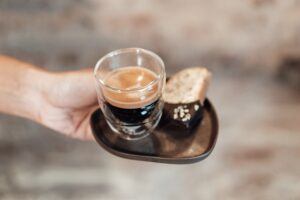
Sour Espresso Temperature – Brew At The Correct Temperature
The ideal espresso brewing temperature is from 195F-205F (92C to 96C). Due to the fact that the water temperature has an effect on extraction yield, the amount of solids that get dissolved into your coffee. Brewing nearer to the 205F, 96C will create a coffee that is more bitter; cooler temperatures nearer the 195F, 92C result in a sour taste.
Adjust your temperature one degree at a time. Pull a shot and test it. TAFO – Test And Find Out!
Yield And Extraction Time
The yield is omni-present and connected to many aspects of coffee brewing, including brew time, water temperature, and dose as well as the tamp.
How long you pull your shot for will determine the yield and will have an effect on the flavor profile as the sour notes are the first elements to be extracted. It is only after that that the sweetness and the oils get extracted.
Too short an extraction, and you will get a high proportion of the bright and sour notes and little, if any, of the sweetness and oils. The result of a short brewing time is a sour tasting brew and a thin watery espresso.
The extraction time is not the most important part of brewing a world-class shot of espresso, but it does play a very important part. The longer the duration of brew time, the higher the yield and the less likely you will get a sour shot.
It is a fine balance as you do not want to over brew and over extract and end up with an overtly bitter coffee.
The average brewing time for a shot of espresso is 25 to 30 seconds with a variance of plus or minus 5 seconds, meaning your shot should not be less than 20 seconds or more than 35 seconds.
Check And Focus On Your Tamp
This is something we touched on earlier and is often overlooked, hence the extra section to draw your attention to the importance of the skill of tamping.
67% of all coffee drinks brewed are an espresso shot – either a shot taken directly, or ristretto, lungo, affogato or as the base for many of the milk based drinks like a cortado, latte, mocha, macchiato, flat white, cappuccino etc.
Paying attention to the tamp and getting it right every single time is important. Perfect practice makes perfect. Focus first on getting a perfectly flat tamp to prevent channelling which leads to under extracted sour coffee.
Once you have that perfect, focus on a good firm tamp. Not too firm as to prevent or inhibit the flow of water. A good firm tamp is needed. Too weak and your water will just run through your coffee grounds and give you a sour taste.
Good quality tamping will serve to slow the flow of your hot water and extend the extraction time.

Check Your Water And Water Filters
Checking your water quality is something you should do frequently. It is not something to test after every shot or every day. Checking it weekly or biweekly is enough.
Water is the main ingredient in coffee – obviously, the better the quality of your water, the better your coffee will be. This is why many people use distilled water (best!), bottled water (second best) and filtered water.
There is no reason at all in the world as to why you should not be using filtered water. This is not a coffee snob thing – it is preventative maintenance and taking care of your espresso machine thing.
Filtered water is not only better, it prevents mineral deposits and lime scale from building up inside your machine, in the pipes, the chambers, boiler, heating elements, the pump and so on.
It’s a win-win for better coffee and helps to prolong its life.
Check your water filter and replace it if necessary. My espresso machine which I have connected to the water mains, has an internal filter which I replace yearly (regardless). I also have an inline filter that I replace every 6 months. I don’t wait until they are dirty to replace them – that is too late.
Frequently Asked Questions About Sour Espresso Shot
Is Espresso Supposed To Be A Little Sour?
A true espresso shot is supposed to have an enjoyable rich caramel notes with hints of sweetness and not a sour taste that is similar to unripened fruit.
If you have a sour taste, you have not pulled a perfect espresso shot and was likely under extracted.
How Do You Get Rid Of Sour In Espresso?
The most common reason for a sour shot of espresso is due to it being under extracted. There are a number of steps you can take, one at a time, and test after each adjustment.
Start with cleaning your espresso machine, pull a shot and test it. If that does not work, try adjusting your extraction time by adjusting the flow rate of the water.
If that does not work, re-adjust the flow rate to what it was previously. Then try adjusting the coffee grind size and changing the coffee to water ratio slightly by using a little more coffee by weight.
There are many adjustments you can make. After each adjustment, TAFO – Test And Find Out!
Is Espresso Supposed To Be Acidic?
No,
an espresso is not supposed to be acidic at all. Espresso beans are roasted for longer and at a higher temperature than other coffee beans and thus are, by nature, less acidic than other beans.
This is the nature of dark roasts; regardless of which coffee drink you are brewing, will be less acidic and that includes an espresso shot.
What Causes Sour Taste In Espresso?
There are a number of causes and reasons why you may have a sour tasting espresso. The main reasons are a dirty machine, too quick an extraction, poor tamping, too large a grind size, too few grinds used by weight, the wrong coffee to water ratio and more.
When fixing the problem, which can be easily fixed, make one change at a time and test it.
Are Espresso Shots Supposed To Be Sour?
No, while some espresso shots based on the flavor profile of the beans can be described as acidic but not overtly so, a sour taste is not at all desired in a shot of espresso. There should be no sour notes in your espresso unless it is within the flavor profile of the beans.
Why Does My Espresso Taste Bitter Or Sour?
A sour tasting espresso is usually due to an under-extracted shot. To fix the problem you will need to extend the brewing time. Assuming the correct weight and dose of coffee is used, you will need to adjust the grind size and make it smaller to encourage greater contact between your coffee and your hot water.
Conversely, a bitter taste and bitter notes in your espresso is a result of an over-extracted espresso. The most likely solution is to use a larger grind size and encourage the water to flow easier between your coffee grinds.
Is Sour Espresso Overextracted?
No, an espresso that tastes sour is due to under extraction, too short a brew time.
Can You Tamp Espresso Too Hard?
Yes, tamping is very important, both too soft and too hard can lead to problems with how the hot water flows between the coffee grinds. Uneven tamping can be a problem too.
Frappé-Ing It All Up – Sour Espresso Shot
There is a lot that you can do to fix a sour espresso shot. As I have put emphasis on in this article, make one change at a time and then pull a test shot to find out. Keep going, keep making the adjustments to what the problem may be.
The starting point is looking at the shot you pulled and the coffee puck. These will give you some tell-tale signs that your espresso is sour and where the problem may be.
Join our cool coffee community and join in the conversation about fixing sour espresso shot or, if you have your own solutions that have worked a treat, share them with your fellow coffee lovers. Find us on Facebook/Meta.






